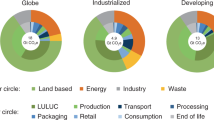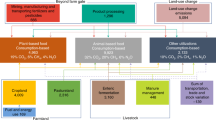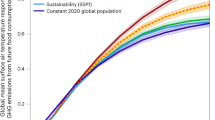Abstract
Food is widely acknowledged as a major contributor to climate change but estimates of food-related greenhouse gas (GHG) emissions frequently consider supply chain stages only up to the farm gate or regional distribution centres. Here we estimate GHG emissions associated with different cooking methods and appliances in the UK. Data on current cooking practices were collected through a survey with more than 700 respondents. Our results reveal that home cooking accounts for as much as 61% of total emissions associated with specific foods, and that this can be substantially reduced through alternative, readily available cooking practices.
This is a preview of subscription content, access via your institution
Access options
Access Nature and 54 other Nature Portfolio journals
Get Nature+, our best-value online-access subscription
$29.99 / 30 days
cancel any time
Subscribe to this journal
Receive 12 digital issues and online access to articles
$119.00 per year
only $9.92 per issue
Buy this article
- Purchase on Springer Link
- Instant access to full article PDF
Prices may be subject to local taxes which are calculated during checkout


Similar content being viewed by others
Data availability
All data that support the findings of this study are available from the corresponding author upon reasonable request.
References
Rosenzweig, C. et al. Climate change responses benefit from a global food system approach. Nat. Food 1, 94–97 (2020).
Frankowska, A., Jeswani, H. K. & Azapagic, A. Environmental impacts of vegetables consumption in the UK. Sci. Total Environ. 682, 80–105 (2019).
Frankowska, A. Environmental impacts on the food–energy–water nexus in the UK food sector. PhD thesis, Univ. Manchester (2019).
Schmidt Rivera, X. C., Espinoza Orias, N. & Azapagic, A. Life cycle environmental impacts of convenience food: comparison of ready and home-made meals. J. Clean. Prod. 73, 294–309 (2014).
Cimini, A. & Moresi, M. Energy efficiency and carbon footprint of home pasta cooking appliances. J. Food Eng. 204, 8–17 (2017).
Reynolds, C. J. Energy embodied in household cookery: the missing part of a sustainable food system? Part 2: A life cycle assessment of roast beef and Yorkshire pudding. Energy Procedia 123, 228–234 (2017).
Clear, A. K., Hazas, M., Morley, J., Friday, A. & Bates, O. Domestic food and sustainable design: a study of university student cooking and its impacts. In Conference on Human Factors in Computing Systems—Proceedings 2447–2456 (Association for Computing Machinery, 2013).
Which of the following household appliances does your household own? Statista Global Consumer Survey 2019 https://www.statista.com/forecasts/997843/household-appliances-ownership-in-the-uk (2019).
Energy Follow-Up Survey 2011: Domestic Appliances, Cooking & Cooling Equipment (DECC, 2011); https://assets.publishing.service.gov.uk/government/uploads/system/uploads/attachment_data/file/274778/9_Domestic_appliances__cooking_and_cooling_equipment.pdf
Annual Conversion Factor Publications (DBEIS, 2019); https://www.gov.uk/government/publications/greenhouse-gas-reporting-conversion-factors-2019
Recchia, L., Cappelli, A., Cini, E., Pegna, F. G. & Boncinelli, P. Environmental sustainability of pasta production chains: an integrated approach for comparing local and global chains. Resources 8, 56 (2019).
Poore, J. & Nemecek, T. Reducing food’s environmental impacts through producers and consumers. Science 360, 987–992 (2018).
Jeswani, H., Burkinshaw, R. & Azapagic, A. Environmental sustainability issues in the food–energy–water nexus: breakfast cereals and snacks. Sustain. Prod. Consum. 2, 17–28 (2015).
Robinson, B., Winans, K., Kendall, A., Dlott, J. & Dlott, F. A life cycle assessment of Agaricus bisporus mushroom production in the USA. Int. J. Life Cycle Assess. 24, 456–467 (2019).
Usubharatana, P. & Phungrassami, H. Life cycle assessment of the straw mushroom production. Appl. Ecol. Environ. Res. 14, 367–382 (2016).
Gunady, M. G. A., Biswas, W., Solah, V. A. & James, A. P. Evaluating the global warming potential of the fresh produce supply chain for strawberries, romaine/cos lettuces (Lactuca sativa), and button mushrooms (Agaricus bisporus) in Western Australia using life cycle assessment (LCA). J. Clean. Prod. 28, 81–87 (2012).
Blonk, H., Kool, A., Luske, B., Ponsioen, T. & Scholten, J. Methodology for Assessing Carbon Footprints of Horticultural Products (Blonk Milieu Advies, 2010).
Frankowska, A., Jeswani, H. K. & Azapagic, A. Life cycle environmental impacts of fruits consumption in the UK. J. Environ. Manage. 248, 109111 (2019).
Noya, I. et al. Carbon and water footprint of pork supply chain in Catalonia: from feed to final products. J. Environ. Manage. 171, 133–143 (2016).
Carbon Footprinting Emissions Report (Quorn, 2019); https://www.quorn.co.uk/files/content/Carbon_Footprint_Results_UK.pdf
Acknowledgements
This research activity was funded through multiple research grants from Research Councils UK, the University of Manchester, the University of Sheffield, the STFC Food Network+ and the HEFCE Catalyst-funded N8 AgriFood Resilience Programme with matched funding from the N8 group of universities. Specific named projects that funded this research include the STFC GCRF-funded project ‘Trends in greenhouse gas emissions from Brazilian foods using GGDOT’ (ST/S003320/1), the STFC-funded project ‘Piloting Zooniverse for food, health and sustainability citizen science’ (ST/T001410/1) and the STFC Food Network+ Awarded Scoping Project ‘Piloting Zooniverse to help us understand citizen food perceptions’. Funding was also supplied from Research England via the University of Sheffield QR Strategic Priorities Fund projects ‘Cooking as part of a sustainable food system—creating an wider evidence base for policy makers’ and ‘Food based citizen science in the UK as a policy tool’. This research project arose from the N8 AgriFood-funded project ‘Greenhouse Gas and Dietary choices Open-source Toolkit (GGDOT) hacknights.’ X.S.R. was supported through Brunel University internal research England GCRF QR Fund. A.K. and C.A.M. were supported through University of Manchester GCRF QR Visiting Researcher Fellowships.
Author information
Authors and Affiliations
Contributions
A.F., X.S.R., S.B., R.B.L. and C.R. conceptualized the study. A.F. provided data analysis. A.F., X.S.R., S.B., A.M.R.G.K., J.T.d.S., C.A.M., F.R., R.B.L. and C.R. developed the methodology. A.F. ran the modelling and conducted the formal analysis. A.F. and J.C. developed the visualizations and figures. A.F. provided the writing (original draft) with X.S.R., S.B., A.M.R.G.K., J.T.d.S., C.A.M., F.R., R.B.L., J.C. and C.R. providing additional writing, review and editing. X.S.R. and C.R. developed the survey, and conducted the data collection and data linking (as part of a wider team). X.S.R., S.B., J.T.d.S., R.B.L. and C.R. provided funding acquisition. X.S.R., S.B. and C.R. provided project administration and team supervision.
Corresponding author
Ethics declarations
Competing interests
The authors declare no competing interests.
Additional information
Peer review information Nature Food thanks N. Rao, P. Behrens and the other, anonymous, reviewer(s) for their contribution to the peer review of this work.
Publisher’s note Springer Nature remains neutral with regard to jurisdictional claims in published maps and institutional affiliations.
Supplementary information
Supplementary Information
Supplementary Text 1, Figs. 1–4, Tables 1 and 2.
Supplementary Data
Cooking impacts per kg raw; cooking impacts per kg cooked.
Rights and permissions
About this article
Cite this article
Frankowska, A., Rivera, X.S., Bridle, S. et al. Impacts of home cooking methods and appliances on the GHG emissions of food. Nat Food 1, 787–791 (2020). https://doi.org/10.1038/s43016-020-00200-w
Received:
Accepted:
Published:
Issue Date:
DOI: https://doi.org/10.1038/s43016-020-00200-w
This article is cited by
-
Product-group-specific nutrient index as a nutritional functional unit for the Life Cycle Assessment of protein-rich foods
The International Journal of Life Cycle Assessment (2023)
-
Extending the product-group-specific approach in nutritional life cycle assessment
The International Journal of Life Cycle Assessment (2023)
-
Sustainable meat consumption: global and regional greenhouse gas emission implications and counterfactual scenario analyses
Environment, Development and Sustainability (2023)
-
Climate Change and Six Americas: What Can Behavior Analysts Do?
Behavior and Social Issues (2022)



